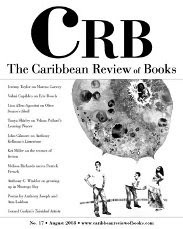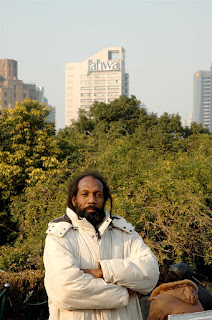
Poetry has always been closest to me: it’s what makes up my inner being, my consciousness expressed through the images and the rhythms; and, in a sense, it wasn’t totally surprising to be told that “Easter Poem” in my new book,
Uncharted Heart, has echoes of T.S. Eliot’s “Ash Wednesday.” In my youth I’d read a fair bit of Eliot, and the deeper resonances of the spirit in Eliot’s poems and plays have stayed with me in unexpected or just amorphous ways.
But
I’m not a religious poet, though religious contexts have always interested me. See, I wrote “Easter Poem” (for two dramatic voices) over twenty-five years ago; and, later, came poems such as “Remember the Light” and “Things We Are,” in this new collection which have religious reference points; and maybe it’s what burgeoned in me growing up in Guyana, South America, where religion and the lack of religion are central, though ours was, and still is, a secular state. In my early novel
The Wizard Swami (Peepal Tree Press), set in a 1950's Guyana, religion forms a backdrop to the overall irony and parody: a work fundamentally about the little man’s struggle in a colonial setting as everything is couched in the central character’s odd or idiosyncratic, if not just picaresque, ways.
In Uncharted Heart I’ve tried to capture internal climates (an epigraph from Mallarme adumbrates this); and, essentially, it’s about trying to find meaning in order to make sense of our complex world. The poet as “maker,” or “myth-making” has always been uppermost, even crucial, I believe; and words, meanings and inferences are about what’s deep in the spirit and expressed in symbols and metaphors oftentimes pulled together–yoked--in the longing for wholeness, or oneness. A transcendental element too informs everything (yogic, maybe: I’ve been reading recently a lot more about Buddhism and Hinduism, if subliminally to find some deeper connection with my forebears, all with Vedic impulses linked into my composite western self).
In many of the new poems in this collection–some written over the past four or five years, and coming after
Hemisphere of Love (TSAR) and
Imaginary Origins: New and Selected Poems (Peepal Tree Press)--I’ve tried to link the deeply personal with the occasional, as everything is tied to history, geography, the sense of destiny and identity while living in North America, with memory being the mother of the muses. Shaping the poem–or simply “staging the poem” as has been said by Billy Collins, I think –is also integral to my overall poetic attitude and process. For me, how the poem appears on the page, and how words meet the eye and silent ear, and the rhythm of the lines and line-breaks (enjambment) in free verse (but not so free) are instinctual in me. It’s what I constantly dwell upon in composing the new poems (and in most of the poems in my previous books).
But in
Uncharted Heart the process has frustrated me more than usual (angst all writers go through, no doubt). And maybe I’ve written my poems in not entirely dissimilar ways from how I write prose (my novel
Drums of My Flesh does have a genuine poetic impulse; and the same goes for my
Dark Swirl, recently reprinted by Peepal Tree Press).
A stream of consciousness aspect is inevitably present in trying to make sense of what’s around me: what I feel intimately; and always for me in the poems, the image is central. In Guyana in the 60's as a beginning writer I recall wrestling with imagism–the image being everything. Then I continually read the British and American poets: Eliot, Spender, Auden, Sitwell, Thomas, and others from east and west, local and international, eclectic as my taste already was. I was also imbued with Lawrence Durrell’s idea of making the image solid as diamond, going beyond loading every rift with ore, it seems, as everything kept impacting on my sensibility: in a tropical environment of jamoon and blacksage amidst birdcalls of the kiskadee and blue-sackie and simultaneously engaging, if only numinously, with Hopkins’ “God’s grandeur” with dialectal sprung rhythms nonetheless. One of the first poems I wrote in Canada was “Green Land”–which is pure imagism, I think; and in
Uncharted Heart, I kept going back to images that have lingered on over the years while coming to grips with a changing self and changing perspectives, and adapting my feelings and emotions while not overlooking history and the sense of timelessness of things. Poems such as “The Visitors Have Come,” “Prehistory,” “New World,” and “Dancing with Girls from China” are counterpointed with their varied and particular echoic effects, I figure.
The new place and home and belonging, more than notional, even if seen in an individual experience of India impacting on the imagination, with a hint of drama, as in “ Burnt Offering” or in “Madurai,” no doubt conveying a hybrid self in the making. Geography, inevitably, is juxtaposed with changing climates, the temporal and spatial: as in “My Arctic Space,” where the persona comes to grips with a pioneering life and the “idea of the north” (Margaret Atwood). Precise language-use and expression seen in “Assault” (an epigraph from Eliot: about the poet’s aim being to “purify the dialect of the tribe”), is integral to the poetic process: the desire to invest language with aesthetic energy in writing that is free of cliches and bureaucratic shibboleth, especially for a poet like myself in Ottawa, where the federal government is located.
These new poems are essentially about formed and unformed spaces and changing tonalities, as I’ve tried to express my feelings without fancy image-making; but through the poems’ particular rhythms, I hope to extend boundaries to a wider, more intricate world. And I keep hoping for epiphanies that awaken to inherent mythologies in poems as diverse as “Praising You,” “My Own Tribe,” “Bear on the Road to Agra,” and “El Dorado.” Indeed, I will keep delving into the human heart, if only to discover what’s still uncharted: what’s just ongoing and is timeless.
***
Cyril Dabydeen’s books of prose and poetry include the novel Drums of My Flesh (a Guyana top prize winner in fiction) and a nominee for the International IMPAC Dublin Literary Prize; Imaginary Origins: New and Selected Poems (Peepal Tree Press, UK) and Play a Song Somebody: Selected Stories (Mosaic Press). His work has appeared in over 60 literary journals, such as the Critical Quarterly (UK), The Fiddlehead, Canadian Literature, Prism International, Grain, The Antigonish Review, Kunapipi (Australia), Wasafiri (UK), and World Literature Today (USA), and in anthologies such as the Oxford, Penguin and Heinemann books of Caribbean Verse. He has also edited A Shapely Fire: Changing the Literary Landscape (Mosaic Press)and Another Way to Dance: Contemporary Asian Poetry in Canada and the USA (TSAR). Cyril has done over 300 readings across Canada, the US, UK and Europe, Asia and the Caribbean (including Trinidad, Guadeloupe, Jamaica, and Cuba). His varied work experiences include activism in social issues; he currently teaches writing in he Department of English, University of Ottawa. He is a former poet laureate of Ottawa, Canada.
























